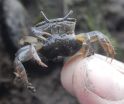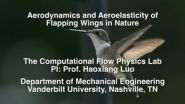(Press-News.org) SAN FRANCISCO (November 24, 2014) --A team of scientists, including researchers from the California Academy of Sciences, has reconstructed a detailed "tree of life" for turtles. The specifics of how turtles are related--to one another, to other reptiles, and even to dinosaurs--have been hotly debated for decades. Next generation sequencing technologies in Academy labs have generated unprecedented amounts of genetic information for a thrilling new look at turtles' evolutionary history. These high-tech lab methods revolutionize the way scientists explore species origins and evolutionary relationships, and provide a strong foundation for future looks into Earth's fossil record.
Research results, appearing in Molecular Phylogenetics and Evolution, describe how a new genetic sequencing technique called Ultra Conserved Elements (UCE) reveal turtles' closest relatives across the animal kingdom. The new genetic tree uses an enormous amount of data to refute the notion that turtles are most closely related to lizards and snakes. Instead, authors place turtles in the newly named group "Archelosauria" with their closest relatives: birds, crocodiles, and dinosaurs. Scientists suspect the new group will be the largest group of vertebrates to ever receive a new scientific name.
The UCE technique used in high-tech labs allowed scientists to move beyond years of speculation and place the Archelosauria group in its rightful place on the reptile tree of life. UCE has been available since 2012, yet scientists are just beginning to tap its potential for generating enormous amounts of genetic data across vertebrates.
"Calling this is an exciting new era of sequencing technology is an understatement," says Brian Simison, PhD, Director of the Academy's Center for Comparative Genomics (CCG) that analyzed the study's massive amount of data. The CCG is a state-of-the-art facility comprised of a sequencing lab, frozen DNA collection, and computing resources that serves as the Academy's core genetic center. Established in the summer of 2008, the CCG continues to refine Academy research--including new turtle findings--on a global, evolutionary scale.
"In the space of just five years, reasonably affordable studies using DNA sequencing have advanced from using only a handful of genetic markers to more than 2,000--an unbelievable amount of DNA," adds Simison. "New techniques like UCE dramatically improve our ability to help resolve decades-long evolutionary mysteries, giving us a clear picture of how animals like turtles evolved on our constantly-changing planet."
Major findings also resolve an evolutionary mystery surrounding softshell turtles--a bizarre group of scale-less turtles with snorkel-like snouts. Until now, studies linked softshell turtles with a smaller semi-aquatic group called mud turtles, despite the fact that softshells appear in the fossil record long before their mud-loving counterparts. The Academy's study places softshells in a league of their own on the evolutionary tree, quite far removed from any turtle relatives. Their long independent history helps explain their striking looks as well as their ancient presence in the fossil record.
Study coauthor James Parham, PhD--Academy Research Associate, Assistant Professor of Geological Sciences at Cal State Fullerton, and renowned turtle expert--says cutting-edge testing techniques bring a new level of clarity to more than two decades of his turtle research. With large amounts of data backing up each evolutionary branch on the turtle tree of life, scientists are able to compare their evolution not only across species, but also across each continent's corresponding fossil records.
"I have been working on the evolutionary relationships of turtles for over 20 years using a variety of methods," says Parham. "Fossils are essential for showing us what extinct turtles looked like, but also in letting us know when and where they lived in the past."
Parham notes that studying turtle fossils--particularly the physical features of their bones--hasn't always painted an accurate evolutionary picture of turtle relationships across continents and through time. "The turtle tree of life based on fossil turtle anatomy didn't match up with the timing of their appearance in the fossil record, as well as their geography," Parham says. "But the tree of life generated at the Academy's CCG is consistent with time and space patterns we've gathered from the fossil record. These new testing techniques help reconcile the information from DNA and fossils, making us confident that we've found the right tree."
INFORMATION:
The California Academy of Sciences is committed to research that unlocks evolutionary mysteries of the natural world. Next-generation advancements used in the Academy's CCG sharpen the way we visualize the past, present, and future of life on Earth, and serve as a blueprint for international excellence in large-scale research.
PRESS CONTACTS:
Haley Bowling, hbowling@calacademy.org, (415) 379-5123
Kelly Mendez, kmendez@calacademy.org, (415) 379-5133
About Research at the California Academy of Sciences
The Institute for Biodiversity Science and Sustainability at the California Academy of Sciences is at the forefront of efforts to understand two of the most important topics of our time: the nature and future of life on Earth. Based in San Francisco, the institute is home to more than 60 research scientists and aquarium biologists, as well as 45.6 million scientific specimens from around the world--nearly 40,000 of which are alive and on display in the Academy's Steinhart Aquarium. The institute also leverages the expertise and efforts of more than 100 international Research and Field Associates and 300 distinguished Fellows. Through expeditions around the globe, captive breeding programs, and investigations in the lab, the institute's scientists strive to understand the evolution and interconnectedness of life. Through these same efforts, as well as through partnerships, community outreach, and public engagement initiatives, the institute aims to guide critical conservation decisions and address the challenge of sustainability. Visit http://www.calacademy.org for more information.
Members of the public in sub-Saharan Africa who are carriers of the hereditary disease sickle cell disease must be educated aggressively through public health campaigns to raise awareness of the risks of parenting offspring with the disease if their partner is also a carrier, according to research published in the International Journal of Medical Engineering and Informatics.
There are many physical and emotional public health components of sickle cell disease, explains William Ebomoyi of the Department of Health Studies College of Health Sciences, Chicago State University, ...
A collaboration between NEC Electronics Samsung and several academic centres in China and Iran, is investigating how software-defined cellular networking might be used to give smart phone users the next generation of super-superfast broadband, 5G. They provide details in the International Journal of Communication Networks and Distributed Systems.
Currently, the fourth generation of mobile phone connection technology, 4G, in as far as it has been adopted provides broadband-type connectivity for enabled devices such as smart phones, tablet computers, laptops and other gadgets ...
WOODS HOLE, Mass.--David Johnson was standing in a salt marsh on the northern Massachusetts coast when he saw a fiddler crab, Uca pugnax, nearly 50 miles north of its supposed natural range. The migration north of this charismatic crab with the big, waving claw may be yet another sign of climate change. Johnson, then a scientist at the Marine Biological Laboratory (MBL) Ecosystems Center, has published his observations in the Journal of Crustacean Biology.
The fiddler crab is an attention-getting crustacean; the males have an oversized claw that they use to attract a ...
VIDEO:
The most detailed aerodynamic simulation of hummingbird flight conducted to date demonstrates that it achieves its aerobatic abilities through a unique set of aerodynamic forces more closely aligned to those...
Click here for more information.
The sight of a tiny hummingbird hovering in front of a flower and then darting to another with lightning speed amazes and delights. But it also leaves watchers with a persistent question: How do they do it?
Now, the most detailed, ...
Over a million US military veterans lacked healthcare coverage in 2012, according to new estimates published in The Lancet. While many people believe that all veterans are covered by the Veterans Affairs health care system, less than half (8.9 million) of the 22 million veterans in the US are covered by VA health benefits, and most veterans are covered by private health insurance. Uninsured veterans are more likely to be young, single, African American, and veterans of Iraq and Afghanistan.
However, the authors of this viewpoint estimate that universal health coverage ...
There has been a growing concern that modern society is increasingly lonely. In 2006, a New York Times article "The Lonely American Just Got a Bit Lonelier" highlighted research that shows a decline in social engagement--people are less likely to join clubs, have fewer close friends, and are less likely to perceive others as trustworthy. However, studies have also shown an increase in extraversion and self-esteem, which suggests loneliness is decreasing.
In an effort to study the societal trend of loneliness, researchers from the University of Queensland and Griffith ...
Abnormal connections between neurons are the likely cause of motor coordination issues seen in autism spectrum disorder. Using a mouse model of autism, scientists from the University of Chicago identified a malfunctioning neural circuit associated with reduced capacity for motor learning. This appears to arise from an inability to eliminate unneeded neural connections in the brain. They report their findings Nov. 24 in Nature Communications.
"We have identified synaptic abnormalities that may play a role in motor problems typically seen in children with autism," said ...
Adult survivors of retinoblastoma, a type of eye cancer that usually develops in early childhood, have few cognitive or social problems decades following their diagnosis and treatment. That's the conclusion of a study published early online in CANCER, a peer-reviewed journal of the American Cancer Society. The findings offer good news for patients, but it's important to continue to monitor for long-term effects as the brain changes throughout life.
While most children with retinoblastoma are successfully cured, little is known about the long-term health of survivors. ...
ATLANTA--Promoting healthy gut microbiota, the bacteria that live in the intestine, can help treat or prevent metabolic syndrome, a combination of risk factors that increases a person's risk for heart disease, diabetes and stroke, according to researchers at Georgia State University and Cornell University. Their findings are published in the journal Gastroenterology.
The study, a follow-up to the research team's previous paper in Science, uses an improved technical approach, making the results more significant.
The research team includes Dr. Andrew Gewirtz, a professor ...
A gene associated with schizophrenia plays a role in brain development and may help to explain the biological process of the disease, according to new Rutgers research.
In the study, published in Biological Psychiatry, Bonnie Firestein, professor in the Department of Cell Biology and Neuroscience, says too much protein expressed by the NOS1AP gene, which has been associated with schizophrenia, causes abnormalities in brain structure and faulty connections between nerve cells that prevent them from communicating properly.
Firestein's research indicates that an overabundance ...




